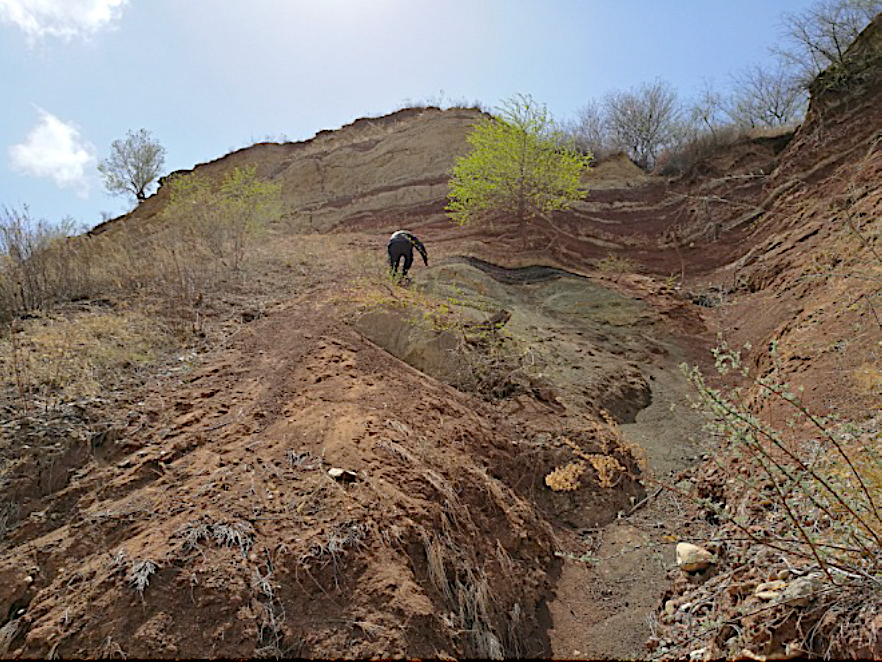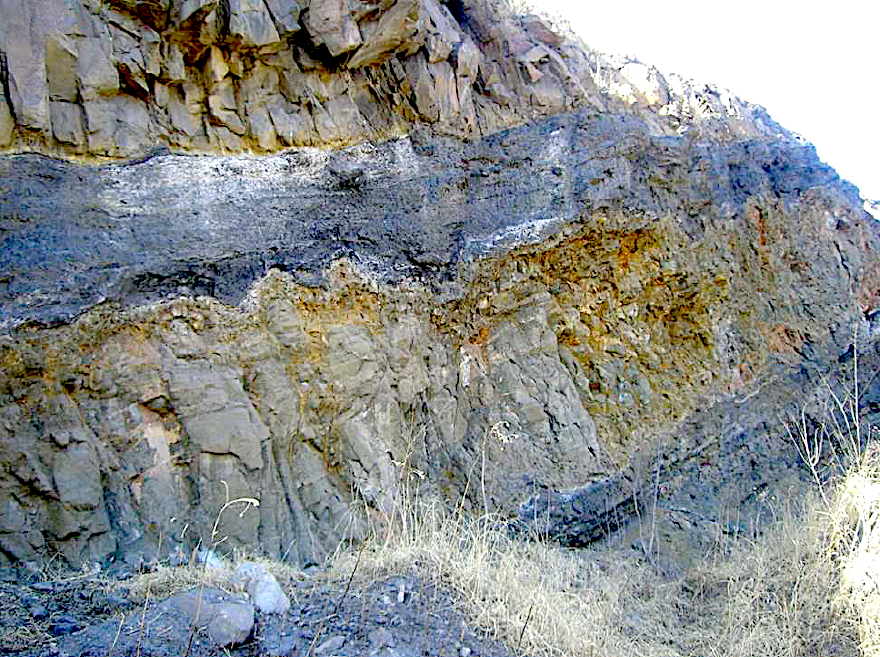Fuxin Fm
Type Locality and Naming
W. Liaoning. Wang Zuquan and Huang Jiqing erected the Fuxin coal measures in 1929. The section for the designation is in Fuxin of Liaoning. The reference section is in the Haichuan Open-Pit Mine of Fuxin.
The Fuxin coal measures erected represents the tuffaceous conglomerate and the coal-bearing beds above the andesite flow of the Fuxin Coalfield, overlain by purple red conglomerate, which was inferred to be of Middle Jurassic age. The Fuxin carbonaceous bed called by W. Muroi in 1943 represented the carbonaceous beds over the Shahai Fm shale and under the Sunjiawan Fm conglomerate, which was assigned to Middle and Late Jurassic. In 1943 S. Oishi and G. Morita (1943) designated the Fuxin series including the volcanic rocks and the four coal beds above them, thus increasing the definition of the Fuxin coal measures, and assigned them to the middle-upper parts of the Fuxin series. In 1962 Gu Zhiwei renamed them the Fuxin coal-bearing formation with the same definition as that of the Fuxin carbonaceous bed designated by W. Muroi and at the same time erected the Haizhou Fm and assigned it to Late Jurassic. In 1962 Gu Zhiwei renamed the Fuxin series designated by S. Oishi and G. Morita (1943) the Fuxin Group and correlated with the Jehol Gr, being defined as Middle-Late Jurassic. In 1965 the Liaoning Regional Geological Survey Team called the Fuxin Group the Binggou Fm in western Liaoning and also assigned it to Late Jurassic. In 1971 the same team called it the Fuxin Formation in eastern Liaoning of the same definition as the Fuxin Carbonaceous bed (W. Muroi, 1940) and the Fuxin coal-bearing formation (Gu Zhiwei, 1962) and was assigned to Late Jurassic. In 1980 Wang Hongzhen et al assigned the Fuxin series to the Lower Cretaceous. In 1985 Wang Wuli et al called the variegated conglomerate and mudstone beds under the Sunjiawan Fm conglomerate and the gray green sandy shale with thin coal seams of the upper Fuxin Formation the Banlazishan Fm in the Banlazishan area of Fuxin, which was assigned to Early Cretaceous. Since 1980 the Fuxin Formation has generally been used continuously until today.
Lithology and Thickness
The Fuxin Formation is mainly represented by coal-bearing strata and was divided into three members. First member is dominated by sandstone and shale with conglomerate and with lower coal bed group; Second member is dominated by sandstone and sandy conglomerate with four coal bed groups; and the Third member is represented by sandy conglomerate with sandstone and thin coal beds, bearing a large amount of floras and sporopollen grains. It is 487.6 m thick.
[Figure: Fuxin Formation in Haichuan Open-Pit Mine of Fuxin, Liaoning Province]
[Figure: Fuxin Formation in Banlashan section of Fuxin, Liaoning Province]
[Figure: Coal beds in Fuxin Formation of Haichuan Open-Pit Mine of Fuxin, Liaoning Province]
Relationships and Distribution
Lower contact
Upper contact
Its top is bounded by gray green and gray white conglomerate with small amounts of gray thin-bedded sandstone, mudstone and carbonaceous mudstone at the base of the Sunjiawan Fm. It is overlain conformably or unconformably by the overlying Sunjiawan Fm or the Quaternary.
Regional extent
The present formation mainly occurs in north Hebei and west Liaoning and varies both in lithology and thickness. In Binggou of Jianchang, the upper part of the formation is built up by sandstone while the middle and lower parts siltstone, with pebble and granule conglomerate at the base. The formation exceeds 575.6 m in thickness. In the Wujiazi Coal Mine, it is built up by sandstone and shale with conglomerate and sandstone, with a thickness of 415 m. In the Taipingfang area, it is mainly represented by silty shale, siltstone and sandstone with conglomerate, with a thickness of 2343.9 m. It is 415-2344 m in western Liaoning, 350-450 m in the Tieling-Faku area, and 69-505 m in northern Hebei. It is called the Changan Fm in the Xifeng area and the Qingshila Fm in northern Hebei. It is the well-known Fuxin coal-producing formation and the Tiefa coal mine is also an important coal-producing formation.
GeoJSON
Fossils
This formation yields a large amount of floras and sporopollen grains and a few number of bivalves and ostracods, including floras: Ginkgo sibirica, Podozamites lanceolatus, Acanthopteris gothani, Coniopteris silapensis, C. burejensis, Ruffordia goeperti; bivalves Ferganoconcha sibirca, Sphaerium shantungense; and in the Taiping bed - the intermediate bed of the Haizhou Open-Pit Mine, ostracods such as Cypridea yabulaiensis, Ziziphocypris simakovi, Candona glaber; and sporopollen grains such as the Cicartricosisporites- Appendicisporites- Clavatipollenites assemblage.
Age
Depositional setting
It is of lake bog facies.
Additional Information
Enhanced with Igor N. Kosenko, Jingeng Sha and Boris N. Shurygin (2021). Upper Mesozoic stratigraphy of Sikhote-Alin (Russian Far East) and northeastern China: Non-marine and marine correlations. Part 1: Upper Jurassic-Hauterivian AND 2. Barremian-Aptian. Cretaceous Research, 124: articles 104811 (https://doi.org/10.1016/j.cretres.2021.104811) AND 104812 (https://doi.org/10.1016/j.cretres.2021.104812)


